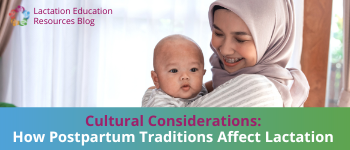Featured
Cultural Considerations: How Postpartum Traditions Affect Lactation


It’s sometimes called the Fourth Trimester, and with good reason–the days, weeks, and months after giving birth are a time when a parent needs special care and support.
However, how parents are supported, what they expect, and what’s expected of them during this time varies greatly by culture.
And sometimes, cultural variations in traditions and practices impact lactation. As a lactation care provider, do you know how to provide culturally humble, respectful, evidence-based care during those beautiful, intense early days?
Postpartum Cultural Variations
Several elements of the postpartum period tend to look different across cultures and communities, and each can influence a parent’s lactation experience. Consider these:
How long? How quickly a new parent is expected to heal from childbirth varies across cultures. Some view the first 40 days as a protected time, offering the birthing parent extra support and fewer expectations. Others place a premium on quick recovery and getting “back to normal” as soon as possible.
Who helps? In Japan, a birthing parent may travel to their family home at 32 weeks of pregnancy and stay until 8 weeks postpartum, supported and cared for by members of the family. In Amish culture, the broader community may rally around the new family, helping to care for older children and the new parent. Some postpartum parents find themselves surrounded with support, while others face it with less help. Culture and community shape this reality.
What’s on the menu? Many cultures consider certain foods important for postpartum healing. Other foods may be viewed as negative for a new parent and are avoided. Some Asian and South American cultures categorize foods as “hot” or “cold” in terms of their effect on the healing parent and encourage or discourage them accordingly. In addition, cultures have their own traditions around what foods are viewed as galactogogues and encouraged for lactating parents.
What is Advised? New parents may be given additional recommendations for healing, based on their culture. Physical warmth, massage, hygiene, and physical activity are all areas where postpartum cultural practices can vary.
Cultural Traditions & Lactation
As a lactation care provider, you frequently encounter parents during the early postpartum period.
They’re seeking your advice, but they are also receiving messages and input from their family and culture–messages and input that can be very important to their sense of belonging and identity at this significant time in their lives.
What steps can you take to make sure you are providing the best possible lactation care with sensitivity and respect to your client’s culture?
Recognize the importance of traditions. Cultural practices and rituals are important for family-building. Come from a place of respect for that importance.
Ask open-ended questions. Allow your client to educate you about their culture and its practices. Listen with an open mind and be willing to learn something new.
Affirm safe practices. If a practice will not do any harm, simply reassure your client that following their cultural or family tradition is fine.
Express concerns appropriately. When there is evidence that a common practice in your client’s culture could compromise lactation, it’s important to talk about it. Share accurate information, with respect. Bring up your concern in a sensitive way and provide evidence-based information in a non-judgemental manner.
Respect their choices. Once you have shared evidence-based information with sensitivity and respect, remember that this is their lactation journey, not yours. They make the decisions for their new family–now supported by your care and accurate information.
Caught Between Cultures
At times, a new breastfeeding parent may find themselves in the middle between their culture (including family members of the older generation) and evidence-based lactation advice. You can help.
First, ensure that you are affirming any practices that are safe and will not cause harm. If your client needs to modify or reject an unsafe practice that their culture values, help them plan strategies for doing those that feel good to them. How can they express their decision to family members in a way that works for them?
You can even role-play with them, helping them put language to the reasons they need to decline a commonly-held tradition. Pretend to be a family member and allow them to practice discussing the issue. Can they safely partake in part of the tradition? With your support, they can find ways to enjoy and embrace their culture and meet their lactation goals.
Ready for more?
Culture is only one of many important factors affecting postpartum recovery. The information in this blog is drawn from our course on this topic Continuing Education: Postpartum Recovery.
Instructor Alison Ward-Moore, MD, IBCLC, covers normal postpartum recovery as well as common complications across three time periods: peripartum and the first two weeks; two to six weeks; and six to 12 weeks.
Explore the Course
Continuing Education: Postpartum Recovery
By accepting you will be accessing a service provided by a third-party external to https://www.lactationtraining.com/

